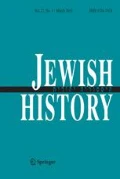Abstract
By examining the Latin inscription of Rabbi Iacob of Mérida (Lusitania, Spain) on the basis of historical and philological arguments we can establish its dating to the early eighth century, after the Arab invasion. This would confirm the survival of sages who had a leading role in the religious life of Jewish or formerly converted Jewish communities able to clandestinely maintain and preserve their ancestral beliefs. Rebbi Iacob, the son of the rebbi Senior is mentioned in the inscription; it is possible that both were “masters of the Law.” It is likely that they chose to practice their teachings orally due to the ban on the production and reading of all kinds of Jewish written works in the Visigothic kingdom.
Similar content being viewed by others
Author information
Authors and Affiliations
Corresponding author
Additional information
Publisher’s Note
Springer Nature remains neutral with regard to jurisdictional claims in published maps and institutional affiliations.
Rights and permissions
About this article
Cite this article
González Salinero, R. The Latin Inscription of Rabbi Jacob of Mérida: Dating and Contextualization. JEW HIST 34, 259–272 (2021). https://doi.org/10.1007/s10835-021-09385-4
Accepted:
Published:
Issue Date:
DOI: https://doi.org/10.1007/s10835-021-09385-4



